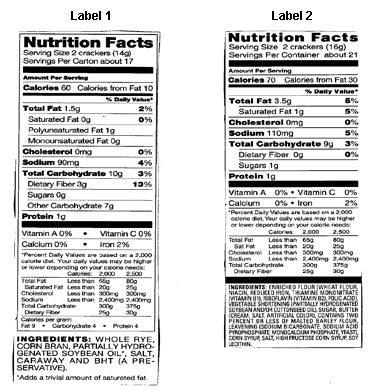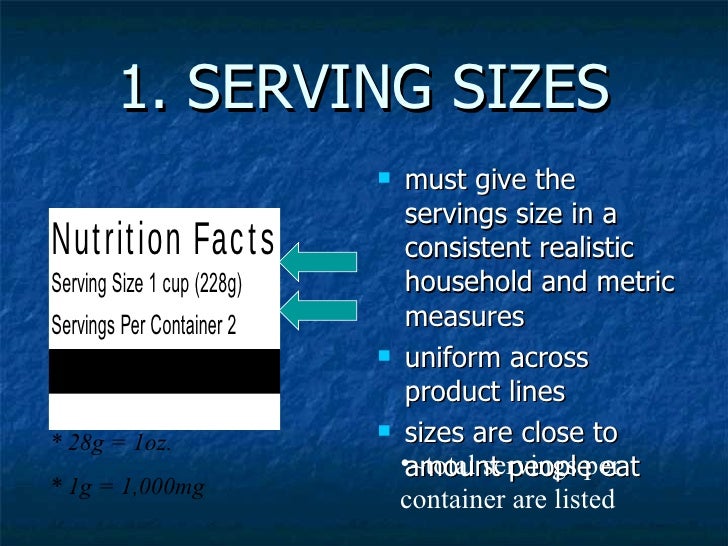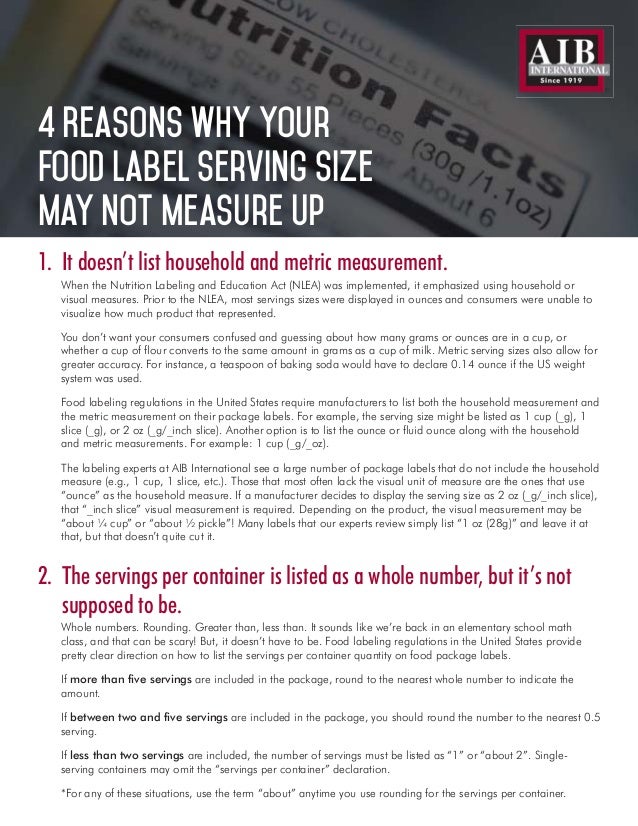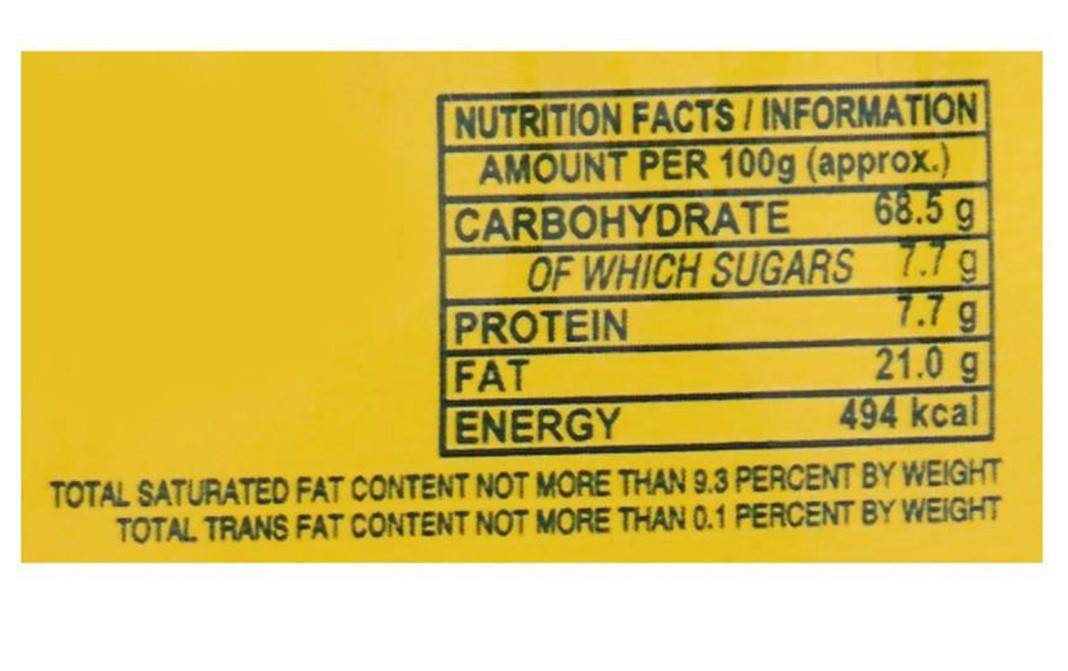41 why are serving sizes standardized on food labels
Nutrition facts label - Wikipedia The nutrition facts label (also known as the nutrition information panel, and other slight variations) is a label required on most packaged food in many countries, showing what nutrients and other ingredients (to limit and get enough of) are in the food. Labels are usually based on official nutritional rating systems.Most countries also release overall nutrition guides for general educational ... Fitness Facts: Serving sizes vs. portion sizes - GCU Today A serving size is a standard amount of food, which you often see written on the Nutrition Facts label on food packaging. These numbers are a general guide of what the average person may eat. A serving size also can be the amount of food served to you if you are eating in a restaurant. A portion size is what you personally eat.
Designing Food Labels For the Visually Impaired - Modern Farmer When asked why Kellogg moved forward with an audio technology, ... That might be ingredients or serving sizes on food or dosages on medicine. It could be quickly differentiating which is the shampoo and which is the conditioner on bottles, making the labels easier to read in the shower. ... "If there's a standardized manufacturing process ...

Why are serving sizes standardized on food labels
How to Understand and Use the Nutrition Facts Label | FDA Serving sizes are standardized to make it easier to compare similar foods; they are provided in familiar units, such as cups or pieces, followed by the metric amount, e.g., the number of grams (g).... There's a Difference Between 'Portion Size' and 'Serving Size' Portion sizes are often quantified using measuring cups or spoons while serving sizes can be based on physical characteristics such as weight or volume. Serving sizes can also be based on the number of calories, grams of sugar, or other nutritional information. A final difference between portion size and serving size is how they're regulated. Guide to Healthy Portion Control - Consumer Reports A serving is a standardized measure of food, set by the Food and Drug Administration, for use on Nutrition Facts labels. This distinction matters because although serving sizes are based on typical...
Why are serving sizes standardized on food labels. The Difference Between 'Portion Size' and 'Serving Size' (and Why It ... Serving sizes: What's on the label. Serving sizes are the standardized amount of food that you see at the top of the Nutrition Facts labels. One package of food can (and often does) contain ... Nutrition Facts Label - IFT.org - Institute of Food Technologists The Nutrition Facts Label, also referred to as the Nutrition Facts Panel, on packaged food and beverage products is intended to help consumers make informed food choices that contribute to a healthy diet. The first Nutrition Facts Label regulations were published in 1993 and launched in 1994. 10 Tips for Reading Food Labels: What to Look For Sugars. Many nutritionists suggest that the first thing you should do when reading a food label is examine the sugars. This is because sugar plays a large role in your overall health, diet, and well-being. Realistically, no food that is great for you is going to have more than 5 grams of sugar. Study the Ingredients List. Put Food Service Guidelines into Organizational Policies and Food ... Promote healthier portion sizes by optimizing the size of plates, bowls, glasses, other dishware, and serving ware. Information. Use information, displays, decorations, and signage to highlight healthier choices. ... label food products at the point of purchase as certified organic, produced with another certified environmentally beneficial ...
Exclusive Q&A: How the Food Labeling Modernization Act will affect ... CL: So now there must be a standardized symbol system that displays caloric information per serving—informational on saturated and trans fats, sodium, and added sugars—and this is in addition to what you normally find on the nutrition facts panel.So all that information is already on the label, but now it's going to be highlighted on the front of the package. Dr. Bridget Gibson: How to evaluate nutrition facts labels The first thing you will see on a nutrition facts label is the serving information, the number of servings contained in one package and the serving size. The serving size indicates the amount... 'Portion Size' and 'Serving Size' Are Not the Same: Why It Matters "Serving size" is based on a standardized amount of food or drink which is established by research done on the eating habits of adults and children. Understanding the difference between portion... Recipe Measurement and Conversion - Cooking Techniques Portion Size Conversion. A foodservice establishment may need to increase or decrease the portion size of a recipe. This is an important skill. Perhaps customers are complaining that the portion size of a dish is too small for the cost. Or, perhaps the portion is so large that it results in little or no profit left over for the establishment. 1.
Serving and Portion Sizes Explained - Lark Health Serving sizes are standard amounts of food. The Academy of Nutrition and Dietetics explains that they are the amounts of food that you may see on a nutrition facts panel. And they can be the amounts you see when you are looking at recommendations for daily intake. Portion sizes are the amounts of food that are served or eaten. Serving Size vs. Portion Size, What's the Difference? - Prevention A serving size is defined as a standardized, measured amount of food. This is most commonly used by the United States Department of Agriculture (USDA) in reference to food groups or printed on... A Guide to Healthy Portion Control - MSN About a third of those surveyed confused portion size with serving size. A serving is a standardized measure of food, set by the Food and Drug Administration, for use on Nutrition Facts labels . IFIC Study Serves Up Reality Check on Serving, Portion Sizes "Helping to control weight" ranked in the top two reasons for 36%, followed by "helping to avoid eating too much of certain foods" (30%) and "helping to know how much they should be eating or drinking" (26%). Sizing Up the Terms: Portion Control
Your guide to understanding Nutrition Facts labels - The Star It's important because serving sizes are not standardized on nutrition labels. Let's say you're comparing yogurt: One brand might have a serving size of 170 g, another might have 225 g. This makes...
IFIC Study Serves Up Reality Check on Serving, Portion Sizes "Helping to control weight" ranked in the top two reasons for 36%, followed by "helping to avoid eating too much of certain foods" (30%) and "helping to know how much they should be eating or...
Serving Size on the New Nutrition Facts Label | FDA Some serving sizes have changed on the new Nutrition Facts label. By law, serving sizes must be based on the amount of food people typically consume, rather than how much they should consume....
The Difference Between 'Portion Size' and 'Serving Size' (and Why It ... It's true that understanding serving sizes helps you make sense of food labels, so that you can get a more accurate sense of the nutritional makeup of your food depending on how many servings you...
Consumer Survey: Understanding Portion and Serving Sizes - Food Insight Regardless of food or beverage category, about half say they try to eat close to the serving size listed on packaging. The top-ranked reasons for paying attention to portion sizes are to help control weight (36% ranked in top 2) and to help avoid eating too much of certain foods (30%).
FDA Food Product Labeling & Packaging Requirements | ESHA Research The Nutrition Facts Label is used to communicate important information about the food consumers eat. The FDA also governs what label format to use on your product based on package size and contents. The Nutrition Facts Label must show: Serving size ( Consult the RACC to determine this) Household measure/common household unit Servings per container
Suggested Servings from Each Food Group | American Heart Association Whole grain rather than refined grain products. Six (6) servings of grains per day. Examples of one serving of grains: One slice bread. One small tortilla. 1 cup ready-to-eat cereal flakes. 1 ounce (⅛ cup) uncooked pasta or rice. ½ cup cooked rice, pasta or cereal. 3 cups popped popcorn.
18 questions with answers in FOOD LABELING | Science topic The food label serving size for spray oils is one fourth or one third of a second of spray which is 0.25 to 0.27 grams of oil - less than 0.5 grams of fat. Consequently, by food labeling law ...
Food Labeling Modernization Act of 2021: What the Bill Would Require "Congress is looking to help this trend along." According to Stevens, the bill looks to better create a standardized symbol that displays calorie information in relation to serving size, as well as information on saturated and trans fats, sodium, added sugars, and any other nutrients that are strongly associated with public health concerns.
Guide to Healthy Portion Control - Consumer Reports A serving is a standardized measure of food, set by the Food and Drug Administration, for use on Nutrition Facts labels. This distinction matters because although serving sizes are based on typical...
There's a Difference Between 'Portion Size' and 'Serving Size' Portion sizes are often quantified using measuring cups or spoons while serving sizes can be based on physical characteristics such as weight or volume. Serving sizes can also be based on the number of calories, grams of sugar, or other nutritional information. A final difference between portion size and serving size is how they're regulated.










Post a Comment for "41 why are serving sizes standardized on food labels"